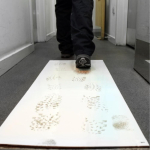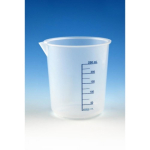Analysis Note
The NIH assay procedure uses 0.2 ml diluted plasma (1:1 with saline) as a substrate and 0.1ml of thrombin sample (stabilized in a 1% buffered albumin solution) based on a modification of the method of Biggs. Only clotting times in the range of 15-25 seconds are used for determining thrombin concentrations.
Application
Thrombin from human plasma has been used: in the preparation of fibrin gels for assessing human bone marrow stromal cells (hBMSC) morphology, in the activation of platelets, to evaluate the integrity of endothelial cell (EC) monolayers
Thrombin is used for site specific cleavage of recombinant fusion proteins containing an accessible thrombin recognition site for removal of affinity tags.
Biochem/physiol Actions
The main function of thrombin is the cleavage of fibrinogen to fibrin, to assist stable clot formation. A wide range of mutations in the prothrombin gene contributes to its deficiency resulting in coagulation disorders like dysprothrombinemia and hypoprothrombinemia. High levels of thrombin elicit neurotoxicity in dopaminergic neurons and contributes to the progression of Parkinson?s disease. Altered thrombin levels modulates the coagulation pathway in multiple sclerosis. Patients with coronary artery disease (CAD) show elevated levels of thrombin. Thrombin accumulation in neurofibrillary tangles of the brain may contribute to the aggregation of tau protein and pathophysiology of Alzheimer disease.
Serine protease that selectively cleaves Arg-Gly bonds in fibrinogen to form fibrin and fibrinopeptides A and B.
Thrombin is used for site specific cleavage of recombinant fusion proteins containing an accessible thrombin recognition site for removal of affinity tags. Thrombin has been used in a study to investigate the protein C pathway in intestinal barrier function.
General description
Thrombin is the final coagulation protease in regard to hemostasis, promoting both procoagulant and anticoagulant effects.
Thrombin is produced from the proteolytic cleavage of inactive prothrombin in the liver. It is a glycoprotein with four structural domains: the 10 ?-carboxylated glutamic acid containing Gal domain, two kringle domains, and the trypsin-like serine protease domain. The prothrombin gene is mapped to human chromosome 11p11.2.
Other Notes
View more information on thrombin at www.sigma-aldrich.com/enzymeexplorer.
Physical form
Lyophilized from saline sodium citrate buffer, pH 6.5
Unit Definition
Activity is expressed in NIH units obtained by direct comparison to a NIH Thrombin Reference Standard










